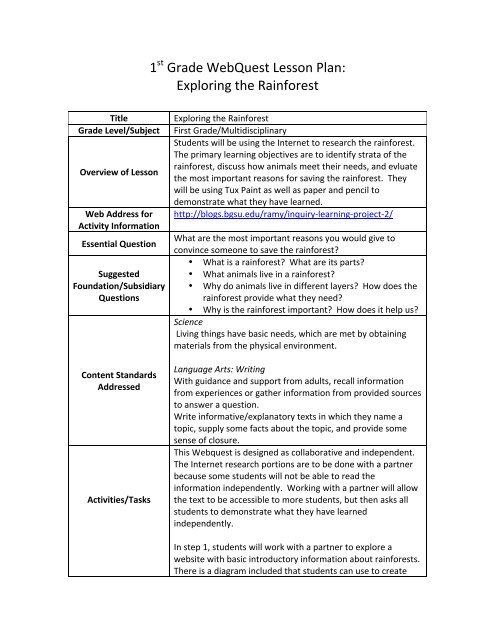1st Grade WebQuest Lesson Plan: Exploring the ... - BGSU Blogs
1st Grade WebQuest Lesson Plan: Exploring the ... - BGSU Blogs
1st Grade WebQuest Lesson Plan: Exploring the ... - BGSU Blogs
You also want an ePaper? Increase the reach of your titles
YUMPU automatically turns print PDFs into web optimized ePapers that Google loves.
1 st <strong>Grade</strong> <strong>WebQuest</strong> <strong>Lesson</strong> <strong>Plan</strong>:<br />
<strong>Exploring</strong> <strong>the</strong> Rainforest<br />
Title <strong>Exploring</strong> <strong>the</strong> Rainforest<br />
<strong>Grade</strong> Level/Subject First <strong>Grade</strong>/Multidisciplinary<br />
Students will be using <strong>the</strong> Internet to research <strong>the</strong> rainforest.<br />
The primary learning objectives are to identify strata of <strong>the</strong><br />
Overview of <strong>Lesson</strong><br />
rainforest, discuss how animals meet <strong>the</strong>ir needs, and evluate<br />
<strong>the</strong> most important reasons for saving <strong>the</strong> rainforest. They<br />
will be using Tux Paint as well as paper and pencil to<br />
demonstrate what <strong>the</strong>y have learned.<br />
Web Address for<br />
Activity Information<br />
http://blogs.bgsu.edu/ramy/inquiry-‐learning-‐project-‐2/<br />
Essential Question<br />
What are <strong>the</strong> most important reasons you would give to<br />
convince someone to save <strong>the</strong> rainforest?<br />
• What is a rainforest? What are its parts?<br />
Suggested<br />
• What animals live in a rainforest?<br />
Foundation/Subsidiary • Why do animals live in different layers? How does <strong>the</strong><br />
Questions<br />
rainforest provide what <strong>the</strong>y need?<br />
•<br />
Science<br />
Why is <strong>the</strong> rainforest important? How does it help us?<br />
Living things have basic needs, which are met by obtaining<br />
materials from <strong>the</strong> physical environment.<br />
Content Standards<br />
Addressed<br />
Activities/Tasks<br />
Language Arts: Writing<br />
With guidance and support from adults, recall information<br />
from experiences or ga<strong>the</strong>r information from provided sources<br />
to answer a question.<br />
Write informative/explanatory texts in which <strong>the</strong>y name a<br />
topic, supply some facts about <strong>the</strong> topic, and provide some<br />
sense of closure.<br />
This Webquest is designed as collaborative and independent.<br />
The Internet research portions are to be done with a partner<br />
because some students will not be able to read <strong>the</strong><br />
information independently. Working with a partner will allow<br />
<strong>the</strong> text to be accessible to more students, but <strong>the</strong>n asks all<br />
students to demonstrate what <strong>the</strong>y have learned<br />
independently.<br />
In step 1, students will work with a partner to explore a<br />
website with basic introductory information about rainforests.<br />
There is a diagram included that students can use to create
Possible Resources<br />
<strong>the</strong>ir own rainforest painting in Tux Paint. They will use <strong>the</strong><br />
four strata, or layers, in <strong>the</strong>ir paintings.<br />
In step 2, students will explore a different website that allows<br />
<strong>the</strong>m to click on a diagram and see where different animals<br />
live. They will record <strong>the</strong> names of <strong>the</strong> animals in <strong>the</strong> correct<br />
place in <strong>the</strong> chart. Deepen students thinking by following up<br />
<strong>the</strong> activity with a discussion about why animals live where<br />
<strong>the</strong>y do. For example:<br />
• Why is <strong>the</strong> macaw <strong>the</strong> only animal listed in <strong>the</strong><br />
emergents layer? Why wouldn’t a poison dart frog live<br />
<strong>the</strong>re?<br />
• What would happen if ants tried to live in <strong>the</strong><br />
understory? Would <strong>the</strong>y have <strong>the</strong> resources <strong>the</strong>y need<br />
to survive?<br />
In Step 3, students will learn about why it is important to save<br />
<strong>the</strong> rainforests. Start by reading and discussing The Great<br />
Kapok Tree by Lynn Cherry. Then allow students to work with<br />
<strong>the</strong>ir partners to explore <strong>the</strong> final website. They should record<br />
ways <strong>the</strong> rainforest is helpful or important. Ask students to<br />
share and discuss <strong>the</strong> reasons to be sure <strong>the</strong>y understand <strong>the</strong><br />
information <strong>the</strong>y found.<br />
Finally, in step 4, students will evaluate which of <strong>the</strong> reasons<br />
<strong>the</strong>y found were most important. Making a decision about <strong>the</strong><br />
most important reasons causes <strong>the</strong>m to think more critically.<br />
They will share <strong>the</strong>ir final decisions in a letter to <strong>the</strong> man who<br />
wanted to cut down <strong>the</strong> tree in The Great Kapok Tree.<br />
United Streaming Video to use as an introduction:<br />
The Tropical Rainforest Habitat<br />
TeacherVision page with links for lesson plans, printables, and<br />
o<strong>the</strong>r activities:<br />
TeacherVision: Rainforests<br />
Teacher Website with lots of links to more in-‐depth<br />
information for teachers:<br />
http://www.naschools.net/teachers/rainforest.htm<br />
Students’ final product will be a letter that <strong>the</strong>y write in which<br />
The Final Product <strong>the</strong>y share <strong>the</strong> most important reasons to protect <strong>the</strong><br />
rainforest.<br />
Assessment See rubric on teacher page<br />
Teacher Commentary The biggest potential obstacles I see in this <strong>WebQuest</strong> is <strong>the</strong>
Reflection amount of text students are exposed to online. The students<br />
are asked to pull information from a body of text much bigger<br />
than <strong>the</strong>y are used to. In order to support <strong>the</strong>m, I have<br />
designed research portions to be done with a partner, asked<br />
<strong>the</strong>m to pull information from diagrams, and followed up<br />
research of important information with class discussions.<br />
This lesson fits into our Rainforest science unit, and ties in as a<br />
writing project for <strong>the</strong> week as well.

















